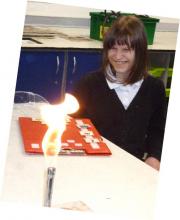
Visual Timetables are the cornerstone of supporting many pupils with ASC. People with autism frequently report that they are visual learners, need the time to understand what is expected of them that pictures allow, need to know what is coming next and need to be comforted that the thing they are being asked to do now (that may not be their favourite activity- work!) will not last forever and there will be things that they like ahead. At their most simple, Visual Timetables/Schedules have a picture of the task to be done now and the reward activity that follows (Do/Reward). Once the pupil understands the principle of "do/reward" the schedule can grow to be as long as the pupil can understand- up to the whole day. For literate pupils they are in written form - ticked off or crossed out as activities are completed. For pre literate pupils we use laminated symbols or photos attached to a board using velcro. It is important that each activity is removed from the schedule as it is completed so that it is visually very clear what is happing now and what is to happen next. Pre literate pupils or their tasks from top to bottom as this is easier to follow than 'left to right'. It is vital that pupils learn to 'trust the Visual Timetable' so staff have to 'wait it out' to insist that every step of the timetable is completed in order. When the pupil 'trusts the schedule' they can relax in the knowledge that they can rely on their understanding of what is expected 'now and next'. This immensely reduces their anxiety that arises from not being sure what will happen and whether or not they can alter what happens through different behaviours (they learn that they can't alter things through inappropriate behaviour and therefore there is no point to that behaviour).
Tips based on our experience:
- Where activities last longer, and the pupil is finding this time difficult, we add up to 5 stars alongside the picture of the activity so that pupils can 'see' time passing and they are progressing towards the next activity. We find 'stars' better to use than a timer as staff can be subltly responsive to the pupil's mood and adjust the timing to help them build on success.
- If a pupil with autism gets upset, we reduce our verbalisations, stay emotionally neutral and simply present or point to the visual schedule with occasion single word reminders/reassurance. If they want to destroy the schedule we get a spare one.
- When introducing schedules with 'do/reward' don't make the first "do" tasks too challenging. Build on success! Make the first "do" tasks fairly easy and the reward really rewarding. Establish the principle and then gradually increase the level of challenge in the "do" task and gradually make the 'size' of the reward more proportionate to the amount of challenge- so that in the end less challenging tasks don't need any immediate reward and can be joined together inbetween rewards.
- Punishments/sanctions/consequences often don't work well with many of our pupils with autism. They simply have to learn that there is no point to inappropriate behaviour because what is on the schedule WILL happen and there is no point worrying about it, trying to avoid it or trying to doing something different. We simply 'wait it out' until they are ready to complete the schedule ("nothing nice until this task is done"). If consequences are used they have to be very clearly, closely, logically connected with a genuine consequence of the behaviour- eg tidying up, not being safe enough to go somewhere - always remembering that it is the 100% reliable schedule that will the main thing that resolves challenging behaviour, not the consequence itself.
- Many parents have told us that they are able to help their child understand expectations, "now and next" etc through their fantastic parent/child relationship. This is often extremely effective until puberty. However, one of the main evolutionary functions of the teenage years is to, in many ways- especially emotionally-, separate from one's parents as part of the process of 'growing up'. Pupils with autism and pupils with learning difficulties are often no different in that, through hormonal changes, they become 'proper teenagers'. Whereas the close child/parent bond has worked incredibly well through the childhood years it often struggles in the teenage years (as it does for many mainstream young people) as the normal biological process takes place. Visual Schedules become absolutely essential at this point to explain to a teenager what is expected. It is far better if the schedule is well established before puberty and therefore we would recommend that parents of pupils with intensive autism start using visual schedules- if they have not done so before- as soon as the pupil moves to High School.
REMEMBER: for a pupil with autism to trust the system it has to be 100% reliable. Many pupils with autism have fantastic memories and if we "let them off" a task on the schedule at any time they will remember and always think that the schedule is 'negotiable'. It can't be 'negotiable' if the pupil is to relax in the knowledge that they fully understand what is expected of them. This is another reason to start off with low challenge as, once the schedule is shown it has to happen!

